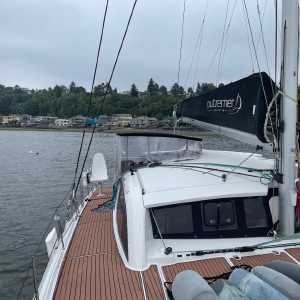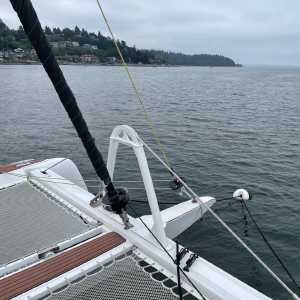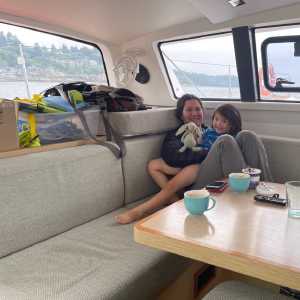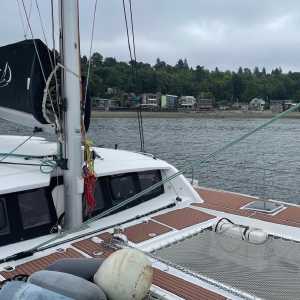First Family Sail
The Plan
We had planned on finding an easy anchorage because we had limited experience anchoring. Friends recommended Blakely Harbor as the easiest anchorage in the area. We had planned to grab the ~11 am slack tide to leave to marina, then cross over to the Port Orchard fuel dock to top off the diesel. Then we would get to the anchorage and set the hook. We would soon learn things don’t always go according to plan.
Leaving the dock did go according to plan. We left the stern tied to the dock and hinged the bow out of our tight parallel park slip, like the boat was a giant 51 foot door. We navigated a few turns out of the marina, at one point getting a little too close to a 75 year old wooden tug boat. At least close enough that the owner came out on deck with boat hook in hand in the customary “don’t you dare hit my boat or I will poke you with my stick” greeting. We cleared out of the marina, then steamed one mile to Port Orchard to get fuel for the dinghy and for Spice.
Fuel Up
There was the tiniest breeze blowing us away from the gas dock, but it was enough to cause us trouble. We used the standard stern first approach, Sarah was standing on the starboard stern. We had the lines tied and ready. I handed Sarah the midship line, but I unknowingly passed it over the top of the life line. When we got close, Sarah stepped off onto the dock and immediately realized the line was running over the top of the life lines. There was no way for her to secure the line without causing lots of damage to the life lines and stanchions. Sarah threw the line in the water, we pulled it in, but the wind had already pushed us too far away from the dock. It was at this time that our friendly neighborhood catamaran docking expert rolled up on his jetski wearing a trucker hat and a nascar t-shirt. We were learning that we cannot dock Spice without attracting a crowd. The sight of a 51’ sailing catamaran is a spectacle and makes for great entertainment when the operators struggle with docking. The wind perfectly carried every bit of commentary to my ears while I struggled to bring spice in stern first for a second time, then a third time. There was no way that the 5 knots breeze was really causing me this much trouble, but it was. “Screw it!”, I said to myself and ignored my catamaran training, “I’m going in bow first.” I brought Spice around and came in Bow first. NASCAR trucker hat stayed on hand to advise on the diesel filling procedure, which was a little helpful in that he advised slow fill instead of fast fill. We fielded the standard litany of comments and questions and attracted a few more dockside spectators, “That’s a beautiful boat, how big is it?” “Thank you, 51 feet” “How fast does it go?” etc. With all tanks full, we were off and on our way.
There was just a bit of breeze, maybe 7 knots, but we wanted to sail and we weren’t in a hurry so we raised the main and pulled out the jib. We arrived at Blakely Harbor after a few hours of sailing. There were quite a few boats already anchored and rafted together. It was uncomfortably tight for us, given our lack of experience anchoring. We hoped that with our shallow draft we could sneak into a spot well back, but no such luck. After motoring between anchored vessels for 30 minutes or so we decided to leave.
We needed a plan B and fast. There wasn’t time to get back to our slip in time for the slack tide. The forecast called for a calm night, so we opted to go to our neighbor’s mooring ball in West Seattle. We thought it would make for an easy and stress free mooring. After all, Sarah, Penny and I had picked up mooring balls plenty of times in the British Virgin Islands. Turns out we were wrong.
Mooring Balls Are Easy, Right?
As we approached the mooring, Sarah was excited to take the helm from me. She had seen many sailing YouTubes featuring females running the boat while their male partners dealt with the lines. I was excited by her excitement. Penny and I ran forward with boat hooks at the ready. On the first pass, Sarah was well lined up. I struggled to grab the ring on the ball, because it was more then 5 feet below the trampoline. The ball wasn’t close enough for my reach. We reset and tried again. This time I was down low and ready with and extra extension on the boat hook. I managed to hook the ring, but the boat drifted back. I couldn’t hold onto the hook and lost it overboard. We grabbed the spare boat hook, reset and tried again. This time I braced myself in the naive hopes I could hold the boat in place with the boat hook, rather than having to let it go to prevent myself from going overboard. I hooked it, but the boat kept moving. I held fast, but the last section of the boat hook pulled clean off and went into the water. We needed another approach, we had no more boat hooks.
I walked back to discuss a new plan with Sarah. I suggested I splash the dinghy, drive the dinghy up to the ball and run a bow line forward, badda-bing, we’d be set. Sarah was not fine with me leaving the boat, she was a bit frustrated with the controls and she wasn’t comfortable running Spice without me. So she insisted she be dinghy captain. I appreciated her directness, her plan was of course the correct one and she was able to cut through my tendency to go into tunnel vision mode and power through problems myself. In that moment, I remembered with shame when I didn’t listen to Sarah and our friend Jason when I had wedged our too large “mini bus” into a too small French village stone alleyway. I simply needed to reverse, but I was stressed out with tunnel vision and I was convinced the only way was forward. I stupidly thought any potential wall-scraping could be averted by moving Jason to the opposite side of the van. Well of course I was wrong, and the mini-Bus was modified with a three foot scrape down its side as a monument to my folly. That memory was an embarrassing reminder that helped me quickly align to with Sarah’s plan.
Sarah got geared up and hopped in the dinghy. She wasn’t familiar with the start procedure or transmission. I walked her through the controls and she was on her way. But the dinghy engine was very temperamental, she got maybe fifty yards away and the engine died. After many attempts she couldn’t get the engine started, and the current and wind had pushed her well away from the mooring ball. Sarah grabbed the oars and started paddling canoe style. Watching her struggle I found myself confounded and frustrated by this whole sequence of events. We were about two hours into this attempted moorage, and here we were, Sarah in the dinghy struggling against wind and current, Penny, Lillie and I on Spice station-keeping best we could against the same wind and current, but while trying to yell advice over to Sarah. I wasn’t sure we could get onto this damned mooring, and this really should be one of the easiest if all methods. What the f@*k are we thinking that we can sail this thing around the world?!
“Use the oars locks!”, I shouted. Sarah looked at the oar locks for a moment, and looked back clearly not seeing how the oar fastens to the oar lock. “Unscrew the ball thingy! Put the pin through the oar”. She secured the oars and she was now rowing, making slow but steady progress. After maybe 15 minutes of hard rowing she made it to the ball. I took the helm of Spice and positioned it close, centered and downwind of the ball, but this essentially meant I had to drive Spice over the top of Sarah and the dinghy. Sarah was between the bows with the cross beam overhead. Penny threw the bowlines to Sarah and Sarah attempted to tie off Spice to the mooring ball. This phase also took nearly 15 minutes for a couple of reasons. First, I had misdirected Sarah to use a bit of lashing as an easier way to temporarily tie off Spice to the mooring. Before she left, I lead her to believe the line tying the engine to the dinghy was the lashing she needed, and she spent a good 5 to 10 minutes struggling to untie 5 year old knots. After realizing that particular cause for delay, I grabbed some strops, ran forward and threw them into the dinghy. Then I ran back to the helm to correct the drift of Spice and prevent the boat from running over Sarah. Next we discovered that Sarah had forgotten how to tie knots. After another few minutes, she managed to tie off Spice best she could. Spice seemed reasonably secured, so I ran forward, jumped off the cross beam into the dingy below and did my best to figure out how to tie off to a mooring ball. I realized that I also didn’t know what the hell I’m doing. I knew running the line from one bow, through the ring and to the other bow was the option that would work, but seemed likely to cause the hulls to get too close or even scrape against the mooring. Well we didn’t have anymore time to screw around, so I ran the line through and tied it off, then we brought the dead dinghy around to the back of the boat with Penny’s help.
Sarah and I hopped onto the transom of Spice, secured to the mooring. We had struggled for two to three hours by this point. We then heard yelling and screaming from the shores of west seattle. I first thought, “Oh crap! What now?” but soon realized that people in houses on the beach were cheering us, they had apparently watched our struggle and were celebrating. I cheered back in appreciation.
By this point, we were way past time for dinner. Everyone was hungry, which only added to the frustration. We had locked Lillie inside the boat on her own during this whole trial. At various points she had been upset and alone, but there was nothing we could do. We finally unlocked the doors and reunited with Lillie. She had unleashed a bit of baby chaos on the boat. There was water all over the floor, pencil scribblings on the galley cabinets and Cheetos smashed into my new iPhone. Half frustrated half amused we laughed.
We cleaned up, made dinner, drank wine and enjoyed the fireworks. Afterward, Sarah went to bed and Penny and I watched Rocky Horror Picture show. Those moments on the boat, surrounded by sunset and mountains brought peace to what was a rather stressful day.
The Way Its Supposed to Work
The next morning we were able to take our time. We made chorizo breakfast tacos, I played around in the dinghy to see if I could sort out the carburetor issues. All I managed to do was change a bad idle problem to a bad throttle up problem. I wasn’t looking forward to this bit of boat maintenance. The last time I attempted to rebuild an carburetor I almost set a marina on fire. The time before that, my friend Casey and I had just completed a carb polish and rebuild on a 1975 Yamaha motorcycle. A motorcycle that also ended up in flames, when Casey encouraged me to ignore the gas smell underneath me and keep jumping on the starter. We stowed the dinghy, weighed anchor and headed back.
I mentioned that this boat attracts a crowd. While I was spinning the boat in the fairway setting up for final approach into our slip, no less than 7 people had gathered at the dock ready to “help”. But we all know they really wanted to see how 51 feet of boat, probably 53 feet with all the sticky-outy bits, was going to fit into a 54 foot slip. We used the stern-first method again, this time with lines lead correctly. Sarah stepped off of the stern and waved off offers help. Then she secured the line and we hinged the boat in like pros.
In the end, we kept the yelling to a minimum and worked the problems as a team. Nothing broke, no one got hurt except perhaps for our pride. We learned a lot about docking, undocking and picking up a mooring, we also added a dinghy engine carburetor rebuild to the todo list. It was a rough introduction to boat life, but was probably exactly the right amount of trouble to earn some experience without pushing us over the edge.




